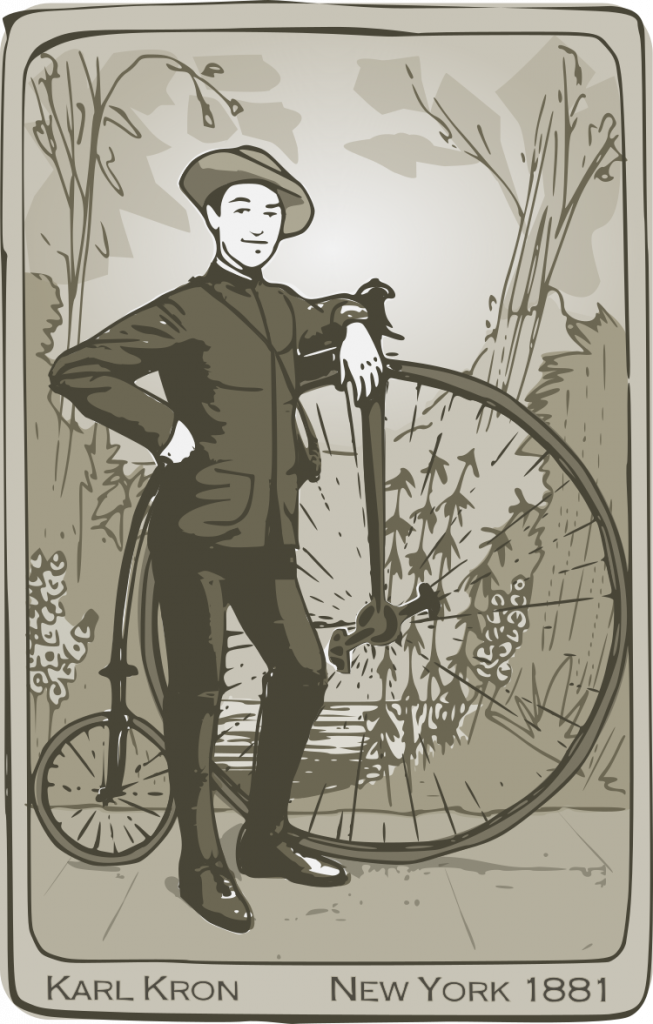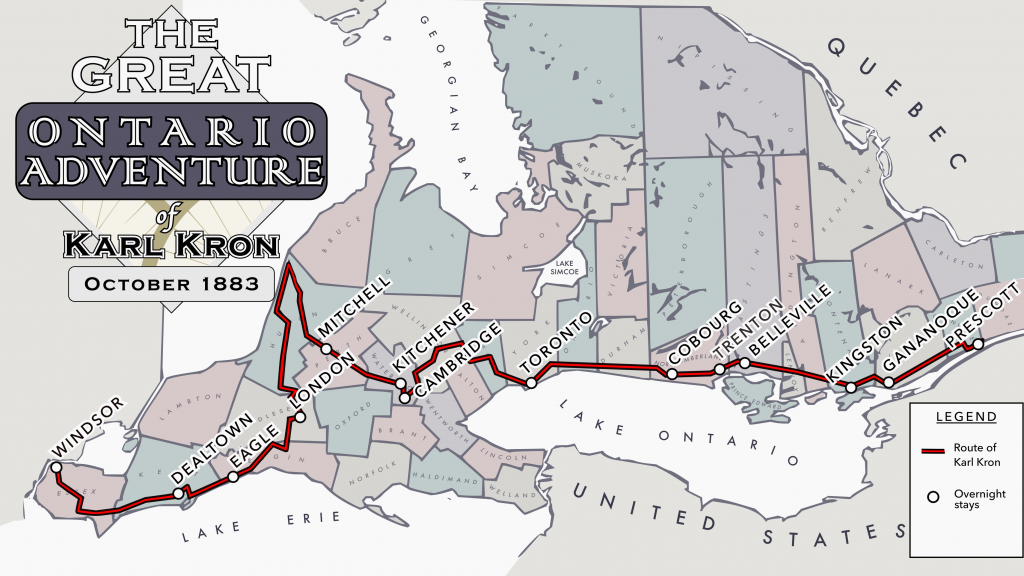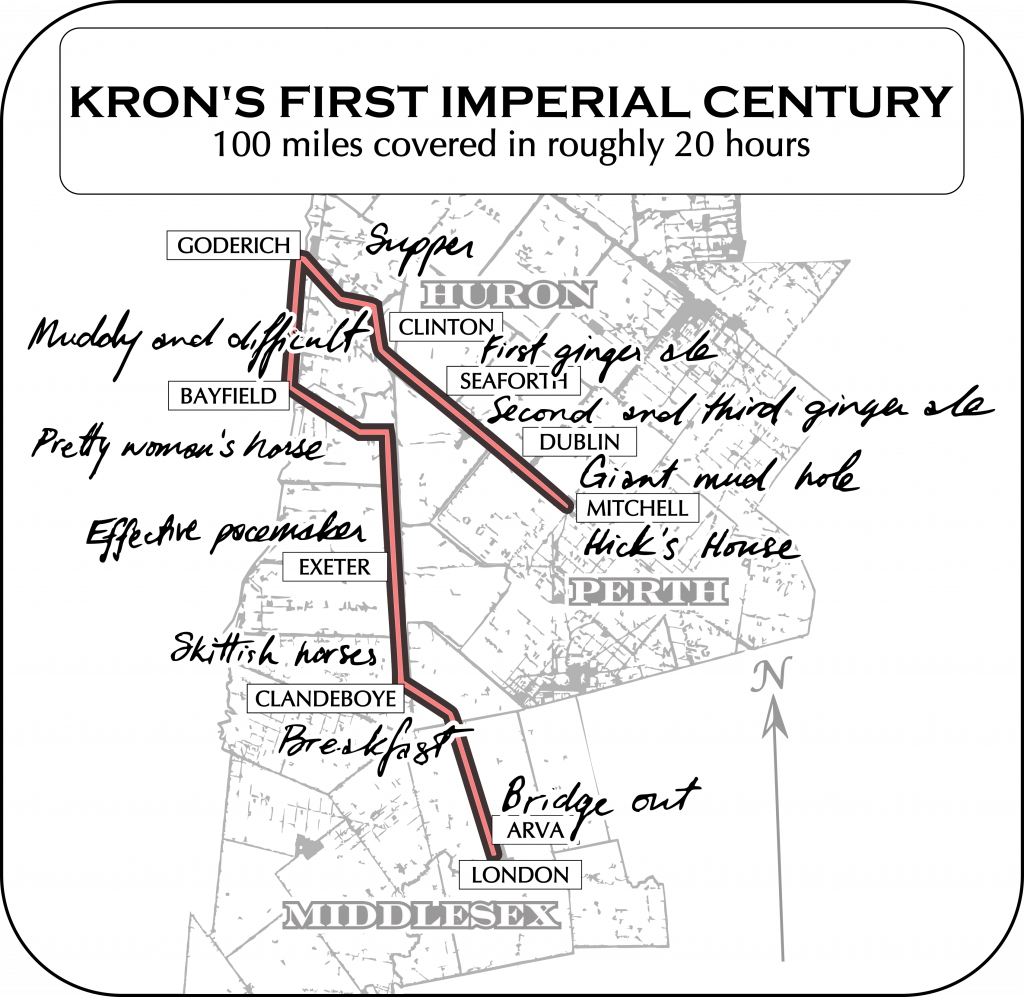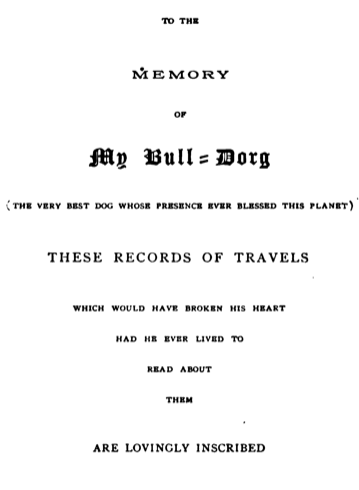Karl Kron (1846-1911), American Bicycling Maven of the Nineteenth Century
If the sport had existed, Karl Kron probably would have been a pretty spectacular randonneur. His book, Ten-Thousand Miles on a Bicycle, reveals that he would have fit into our club very well: like us, he wanted to ride his bicycle far, and, like us, he enjoyed cycling in Ontario. Not that he rode all his 10,000 miles here. Over an approximately six-year period, he toured all over the eastern US, from Kentucky to Illinois, and from Maine to Virginia. He even took his bike to Bermuda. He got around. That he did it all on a penny-farthing bicycle makes it even more impressive. In 1883, he made two rides in Canada. The first, in August, took him through Nova Scotia, New Brunswick, and Prince Edward Island. The second, in October, took him across southern Ontario.

Kron self-published his Ten-Thousand Miles on a Bicycle in 1887, and it is an indispensable primary source for anyone interested in the early days of cycling in North America. In it he recounts all his travels around the United States and Canada. He also describes related matters, like the purchase of his bicycle, the emergence and growth of the first American cycling clubs, bicycle maintenance, and early riding methods, clothing and equipment. Throughout the entire book, Kron discusses the quality of roads in the era before cars (spoiler alert – they were very bad). At over 900 pages in length, Ten Thousand Miles on a Bicycle feels very authoritative. There is no question that Kron was an experienced and knowledgeable cyclist.
Karl Kron, Bicycling “Crank”
But another thing that emerges, very quickly, is that Kron is an eccentric. He is an unapologetic one, and often descends quite steeply into the ridiculous. First of all, his real name was Lyman Hotchkiss Bagg. He created the pseudonym Karl Kron out of “Col. Chron.,” an abbreviation of “College Chronicle,” the name of his column in World magazine (Norcliffe 158). Second, his entire book takes thoroughness to an absurd extreme. The preface is 107 pages long: it has a meticulously detailed table of contents, a general index, an index of places listing every geographical feature he could have conceivably seen from the road, an index of every single person he encountered, and four addenda. There are countless examples of extraordinary scrupulousness such as these. If there is a circle in Hell reserved for the excessively detailed and pedantic, Kron is most certainly there.
But that is not all: as his title hints, Kron took a keen interest in racking up the miles. Using his brass cyclometer, he recorded them to the nearest quarter mile: in 1879, he rode 742 miles over 47 days; in 1880, it was 1 474 ½ miles in 58 days; in 1882, 1 956 miles in 67 days… etc. But miles ridden are not enough for Kron. No, he also recounts all the miles he traveled with his bicycle in tow, be it on a train (he provides the number and route of each one), on a steamboat, on a canal narrowboat, or in a wagon. He even discusses all the travel he undertook associated with the bicycle’s production.
Lastly, perhaps the strongest example of Kron’s eccentricity is the chapter about his dog, Curl. There is absolutely no connection between his pet and his bicycle. In fact, Curl died ten years before Kron even owned his bicycle. He acknowledges the lack of connection and actually admits that he included the chapter about Curl because he couldn’t get it published anywhere else. The book opens with an illustration of the dog, and follows with this dedication:
I don’t mean to poke fun, but Kron just made me think of a reading dog, one whose heart is breaking as he learns all the details of his owner’s cycling addiction. But I digress.
So, yes, Kron’s Ten-Thousand Miles on a Bicycle is an important source of information about the early days of cycling, but it is one with numerous and sometimes glaring flaws. It is available for free as a pdf on Google Books, but before you download it, consider yourself forewarned. It might be the most unusual book about cycling ever written.
The Great Ontario Adventure of Karl Kron, October 1883
It would be a mistake, however, to completely dismiss Kron. Yes, he was too isolated: he did not know how to share what was universally appealing or interesting about his impressive cycling experiences. True, he was too focused on cataloging details – every single one of them: it never occurred to him that he should be telling a story (and doing it with considerably fewer words). But sometimes, despite himself, Kron does talk about his cycling experiences in an almost relatable way.
One of those occasions is when he describes his ride across southern Ontario. Starting in Windsor, he went eastward, meandering through Huron Chapter country, then straight across Toronto Chapter land, and ending in the domain of the Ottawa Chapter. Yes, he is still verbose and boastful, but it is interesting to read about what cycling in Ontario was like all those years ago.

Mechanical difficulties were completely different back then. There were no inner tubes to puncture. There weren’t even any cables or chains to snap. Troubles were much more catastrophic, like large chunks of your bike falling to pieces. This happened to Kron near Georgetown when his handlebars snapped in two. He had to walk into town and get a new set forged. Horses still dominated the countryside in 1883, so blacksmiths were easy to find.
Public electricity was not yet available. This meant the country roads at night were completely dark. Nor were there any viable forms of lighting fixtures for bicycles. Moonlight was essential. Riding in Ontario in the autumn, Kron often had the added benefit of frost, which made the road glimmer in the moonlight and helped him stay out of the ditches. Otherwise, night riding was slow and dangerous. It often meant walking.
Diet was more restricted. There were fewer places to stop for food. Kron often talks about taking quarts of milk, which I suppose means he stopped at farms. He also rode for long periods of time without taking in any food at all.
Kron rarely discusses the landscape. He is only interested in road conditions and the number of miles he can cover on them. His first description of the land only comes on the seventh day of his tour when he passes his first cedar grove in a place called Osprey, near Guelph. The only other comment he has about all the land features between Windsor and Guelph is that the countryside is “open” with “long hills in the teeth of the wind,” “affording fine views of the autumn foliage.” I would prefer to have more descriptions of what the landscape looked like back then, but I think that is asking too much of Kron. If it’s not a road, Kron doesn’t see it.
All his attention on the roads makes one thing very clear: they were bad, very bad. Kron often complains about them:
The 13 miles ending at Goderich at 4:30 P.M. were done in 2 hours, though level roadway (much of it in sight of Lake Huron) was nearly all muddy and difficult (313).
And elsewhere…
My cyclometer said it was 14 miles, I got over it at the rate of 3 miles per hour, with occasional bits of riding (312).
Glen Norcliffe, in his Ride to Modernity: The Bicycle in Canada, 1869-1900, gives a thorough description of Ontario roads in the late nineteenth century. They were not paved, none of them. Your best chance was to ride on macadam. These were dirt roads covered with compacted gravel that might be mixed with sand and finer gravel. If the road was not macadamized, you had to ride directly on dirt, and then the local topography dictated. Sand was a challenge, especially when it was dry. Clay — wet or dry — was a nightmare. After a rain, clay became slick. When dry, it hardened into ruts made by wagon wheels when the road had been wet. Road conditions also depended on the locality: available raw materials and local attentiveness often determined road surfaces as much as mother nature (Norcliffe 166-8).
So, dismounting and walking your bicycle was an integral part of any ride in the late nineteenth century. Sometimes the walking would carry on for great distances. Stretches of riding “without dismount” are noteworthy. Kron made a thorough preliminary research of road conditions throughout southern Ontario before his arrival. Yes, he includes all his research as a very long footnote (314-6). He wanted to have a sense of the walking to riding ratio before embarking on his tour.
His research revealed that Ontario roads were relatively good, and he came here with the intention of completing 100 miles in one day, an accomplishment that had proven elusive on other tours. It took him four days to get from Windsor to London, but on 11 October he set off at 5:45 am with the aim of completing an imperial century.
Things began inauspiciously with the bridge out at Arva. He spent 15 minutes walking through the sandy creek. Then things quickly improved. Within three hours he had already covered 20 miles. As a reward he stopped for breakfast in Clandeboye. After breakfast, there was a brief dismount “to avoid skittish horses,” but from there he carried on without difficulty to Exeter where he “imbibed two lemonades.” It was now 11:10 am and Kron had already covered 34 miles. Exiting Exeter, he chased a horse and buggy: the driver was trying to outrun Kron and “served very effectively as a pace-maker.” Between Exeter and Bayfield, our intrepid hero covered a distance of 22 miles in 2 hours and 22 minutes, “the swiftest of all my long straightaway stays in the saddle.” He would have been even faster had he not had to halt “as a precaution against frightening a pretty woman’s horse.” It was now 2pm and Kron had covered 56 miles. Road conditions on the approach to Goderich slowed him down considerably, but he persevered. By 5:45pm, he had completed 72 miles, “the longest distance ever done by me in twelve hours.”

Reference: Maps of Huron, Perth and Middlesex counties sketched from references at the Canadian County Atlas Digital Project. (Copyright T. Ormond, 2021)
The hills he encountered after Goderich took their toll on his morale. He stopped for two hours at a hotel in Holmesville where he bathed, changed his clothes, and had supper. He had now completed 76 miles. It was here that he learned about the hotel in Mitchell, a place called Hicks House. It was 24 miles away: if he reached it before sunrise he would accomplish his 100-mile goal. Anticipating good weather, and counting on a full moon, Kron set off into the late afternoon with the expectation of reaching Mitchell in the wee hours of the morning.
But things did not go according to plan: having reached Clinton by 9:15, the clouds moved in to cover the moon and the wind turned abruptly against him. Kron kicked back a ginger ale to steel himself against these contingencies. He continued on to Seaforth, covering 9 miles in two hours. Conditions did not improve: he bought two more ginger ales. By midnight his cyclometer stood at 91 miles: “the wind blew against me with increasing force, the mist thickened, and the darkness deepened, so that the track grew much more obscure.” He was riding without any sort of lighting to speak of. He found that there were giant rocks in the road and so he walked in order to avoid them. Reaching the hamlet of Dublin at 1am, and with only 6 miles remaining until Mitchell, Kron noticed the road suddenly smoothen beneath his feet. He started riding again. Without light to read his cyclometer, Kron counted wheel revolutions in order to calculate his distance traversed. (Leave it to Kron to bring pi onto a bike ride…) By the time he had counted four miles, he suddenly fell into a mud hole. The road, again, had become too dangerous for night riding. He walked the remaining distance to Mitchell, where he found Hicks House at 2 am. “I had to kick and hammer for a long while before I could arouse the proprietor. Meanwhile the rain began to fall.” Kron had covered his much sought after 100 miles in one day.
His tour across Ontario continued to Prescott, where he crossed the St. Lawrence River and returned to the US at Ogdensburg, NY. Along the way he stopped in Toronto and became acquainted with some of the cycling club luminaries around there. For those curious to read more, his Ten Thousand Miles on a Bicycle is available on Google Books for free. The relevant chapters about Canadian tours are “Nova Scotia and the Islands Beyond” (282-293), and “Thousand Islands to Natural Bridge” (334-352). I got my information for this article from the first chapter of his book and “A Fortnight in Ontario” (310-333). Glen Norcliffe’s The Ride to Modernity: The Bicycle in Canada, 1869-1900 was another important source for this article.
Conclusion. A Feast in the Time of the Plague? … or just a snack?
Karl Kron’s Ten-Thousand Miles lies far outside the norm. Not that there is anything wrong with that, but it would be so much easier to tolerate if he were a good writer too. There have been plenty of very oddball authors whose idiosyncrasies have been softened by good craft and the regular employment of le mot juste. Not so in Kron’s case.
There is nevertheless something enjoyable about his book. When taken in small chunks and with several enormous grains of salt, I found it …not quite intolerable. I did genuinely get some vicarious pleasure imagining him with his 46-inch wheeled penny-farthing bicycle touring across southern Ontario with horses on macadam, sand and clay.
And yet, I fear that my diving into the world of Kron might have been a reflex and not a choice. Maybe it is just because of the unusual context I find myself in, it being COVID-19 and all. Under normal circumstances, I might not have downloaded and read this book, written an article about it, and made three illustrations. After all, this is a man that history almost forgot.
Meh. Perhaps it is unwise to dwell on normal circumstances …
There most certainly will be a future, but for now there is lockdown. And if we are in a lockdown then there is time for Karl Kron. The 900-plus pages of his Ten-Thousand Miles on a Bicycle will have to serve as my feast in the time of the plague.


Thank you for sharing. I found your article really interesting and it has saved me from reading the 900 plus page book.